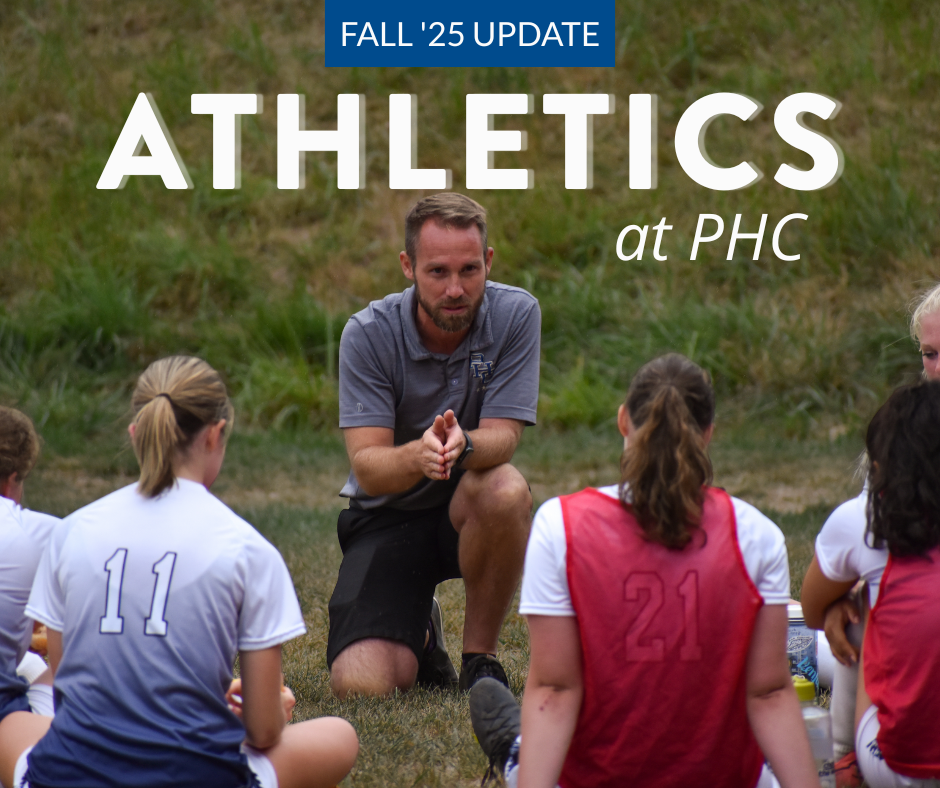Sometimes, it feels like you just finished midterm exams and papers, and somehow, finals have already crept up. Whether you are an upperclassman or a freshman about to finish your first year of...
Read MorePHC alumnus David Bainbridge wins UVA Law Moot Court tournament
Posted by Andrea LaBelle on 11/24/25 2:53 PM
David Bainbridge (APP, '22) and his partner Eric Meinerding won the 97th William Minor Lile Moot Court competition at the University of Virginia School of Law (UVA Law) on November 6.
Read MorePHC hosts the LARGEST moot court competition in America
Posted by Patrick Henry College on 10/27/25 1:05 PM
Patrick Henry College hosted its annual Moot Court Sentinel Classic In-House Tournament, a required part of PHC's robust Core Curriculum. The strongest competitors earn a spot in PHC's top moot court...
Read MorePhilip Bunn as a professor and ISI award recipient
Posted by Andrea LaBelle on 10/27/25 1:04 PM
Philip Bunn (Political Theory, '17), who currently serves on PHC’s Alumni Association Board and as an Assistant Professor of Political Science at Covenant College, was awarded an Intercollegiate...
Read MoreA competitive soccer season for the Sentinels, plus a new Volleyball Club!
Posted by Trevor Good on 10/24/25 5:04 PM
Patrick Henry College's Athletics program is on the rise! The Sentinel teams—particularly women's Soccer—have improved and grown more competitive. And it shows in the number of wins they are...
Read MoreOpen home: Dr. Jackson on the importance of hospitality
Posted by Trevor Good on 10/15/25 8:33 AM
PHC’s Professor of Biology, Dr. Mike Jackson, explained why hospitality is central to Christian community—and to Patrick Henry College. The Jackson family was particularly drawn to PHC because of the...
Read MorePHC student's article highlighted in the National Review
Posted by Andrea LaBelle on 10/15/25 8:30 AM
Over the summer, CLA major and sophomore Harrison Hutton interned with the John Locke Foundation and freelanced for the James G. Martin Center for Academic Renewal. An article he wrote for the Martin...
Read MoreChoosing to live in the light
Posted by Abigail Archer on 9/25/25 5:09 PM
Spanish worship music and upbeat percussion floated through the room. Bright white lights and sunshine shone upon 14 black-haired girls as they swayed, spun, and clapped to the rhythm. A red, white,...
Read MoreTurning pages for Creative Writing students
Posted by Kinsey Jansen on 9/25/25 5:08 PM
When she was growing up, people often asked PHC alumna Rachel Hankinson (Literature, '21) if she would follow in her mom’s footsteps and become a teacher. “No, I don't want to teach. Never, never,...
Read MoreA "solid academic foundation" for law and life
Posted by Andrea LaBelle on 9/22/25 3:08 PM
"I'm participating in God's creation in helping to promote the Good, the True, and the Beautiful." David Shaw, a 2005 PHC graduate with a BA in Government, went on to earn his J.D. from Georgetown...
Read MoreSearch LearnPHC posts by keyword(s)
Popular Posts
Browse by Category
- college (172)
- Patrick Henry College (140)
- PHC (129)
- College Education (125)
- liberal arts (122)
- student life (122)
- College Students (116)
- classical liberal arts (116)
- christian (107)
- campus life (100)
- classical christian liberal arts (95)
- PatrickHenryCollege (87)
- top christian college (80)
- Student Spotlight (79)
- High School (78)
- Spiritual Life (75)
- christian education (70)
- students (70)
- Leadership (66)
- Conservative Christian College (65)
- conservative (63)
- conservativechristiancollege (61)
- Biblical Worldview (56)
- Alumni Spotlight (55)
- college life (54)
- Worldview (53)
- Community (51)
- PHC Prepared (50)
- education (50)
- classical (44)
- religious liberty (44)
- academic (41)
- student (41)
- jobs (40)
- Internships and Apprenticeships (37)
- alumni (37)
- faith (37)
- Faculty (34)
- biblical truth (34)
- Core (33)
- LiberalArts (33)
- bachelor of arts (33)
- College Truths (32)
- Teaching (32)
- Alumni Work (31)
- private college (30)
- College Prep (29)
- History (28)
- journalism (28)
- politics (27)
- admissions (26)
- alumni profile (26)
- department of classical liberal arts (25)
- internship (25)
- learning (24)
- literature (24)
- student body (24)
- study (23)
- Professors (22)
- Economics and Business Analytics (21)
- American Politics and Policy (20)
- Bible (20)
- government (20)
- history major (20)
- Distinctives (19)
- Faculty Spotlight (19)
- literature major (19)
- phclife (19)
- quizzes (19)
- Strategic Intelligence (18)
- dorm life (18)
- government major (18)
- music (18)
- pre-law (18)
- constitutional law (17)
- experience (16)
- Local Community (15)
- moot court (15)
- music department (15)
- quiz (15)
- student involvement (15)
- teen camps (15)
- Culture (14)
- classes (14)
- collegetruths (14)
- interview (14)
- senior (14)
- student organizations (14)
- EnvironmentalScience&Stewardship (13)
- classics (13)
- department of government (13)
- forensics (13)
- political theory (13)
- mentorship (12)
- professional (12)
- science (12)
- truth (12)
- writing (12)
- Applying to College (11)
- CLA (11)
- career guidance (11)
- classical education (11)
- curriculum (11)
- debate (11)
- excellence (11)
- free speech (11)
- freshman (11)
- international (11)
- political journalism (11)
- professionalism (11)
- purcellville (11)
- virtue (11)
- student activities (10)
- theology (10)
- Admission (9)
- Presentations (9)
- Travel (9)
- faith and reason (9)
- family (9)
- friend (9)
- gender identity (9)
- law school (9)
- resume (9)
- white house (9)
- Jesus (8)
- Michael Farris (8)
- alliance defending freedom (8)
- athletics (8)
- full-time-faculty (8)
- imago dei (8)
- lifeatphc (8)
- orientation (8)
- political philosophy (8)
- Intelligence Community (7)
- Mental health (7)
- Pro-Life (7)
- apprenticeships (7)
- character (7)
- fun (7)
- homeschool (7)
- prayer (7)
- sports (7)
- western civilization (7)
- Education News (6)
- Harmful History (6)
- PatrickHenryCollegeNews (6)
- arts (6)
- book (6)
- c.s. lewis (6)
- christians (6)
- entrepreneurship (6)
- fellowship (6)
- freshman class (6)
- job interview (6)
- law (6)
- mock trial (6)
- philosophy (6)
- public policy (6)
- teen leadership camps (6)
- the human soul (6)
- College applications (5)
- God's Word (5)
- Herald (5)
- International policy (5)
- america (5)
- church (5)
- english (5)
- events (5)
- extracurriculars (5)
- job (5)
- local politics (5)
- loudoun county (5)
- ministry (5)
- organization (5)
- parents (5)
- resident assistant (5)
- worship (5)
- 2024 (4)
- Application (4)
- College Programs (4)
- Storytelling (4)
- chapel (4)
- christmas (4)
- cover letter (4)
- discipleship (4)
- distance learning (4)
- finances (4)
- friendship (4)
- grad school (4)
- graduation (4)
- intelligence (4)
- math (4)
- missions trip (4)
- soccer (4)
- study abroad (4)
- tech tips (4)
- theater (4)
- videos (4)
- Business News (3)
- Department of Biblical Studies (3)
- EBA (3)
- Integrated Math & Natural Sciences (3)
- LSAT (3)
- March for Life (3)
- Moot Court competition (3)
- PHIG (3)
- adjunct-faculty (3)
- advent (3)
- advice (3)
- basketball (3)
- biology (3)
- chorale (3)
- civic debate (3)
- concert (3)
- cyber (3)
- cyber challenge (3)
- eduction (3)
- english major (3)
- ess (3)
- freedom (3)
- global studies (3)
- healthy habits (3)
- national security (3)
- online classes (3)
- personhood (3)
- phcprepared (3)
- reason (3)
- religious persecution (3)
- volunteering (3)
- wing chapel (3)
- ACTA (2)
- Bible Bee (2)
- Christian Encounter Ranch (2)
- Christian community (2)
- Core Curriculum (2)
- Filmmaking (2)
- Fox (2)
- Generation Joshua (2)
- Homeland Security (2)
- International Politics & Policy (2)
- Lifestyle Writing (2)
- Ministerial to Advance Religious Freedom (2)
- Ministry partners (2)
- North Korea (2)
- Pre-Med (2)
- Resident Directors (2)
- STEM (2)
- Student Government (2)
- What Will They Learn (2)
- advocacy (2)
- apologetics (2)
- author (2)
- camps (2)
- chemistry (2)
- chorale tour (2)
- churches (2)
- civic virtue (2)
- clubs (2)
- counselors (2)
- dorm (2)
- drama troupe (2)
- essay (2)
- film (2)
- foreign language (2)
- genj (2)
- grace (2)
- graduate (2)
- intramural (2)
- isi (2)
- israel (2)
- lessons & carols (2)
- ministry abroad (2)
- missions' work (2)
- music minor (2)
- new dorm (2)
- physics (2)
- play (2)
- political freedom (2)
- scholarships (2)
- senior testimony (2)
- shapingtheculture (2)
- shiloh (2)
- student workers (2)
- studentworker (2)
- technology (2)
- theatre (2)
- top conservative college (2)
- values (2)
- virtuous life (2)
- worldview academy (2)
- 21 Wilberforce (1)
- AI (1)
- CIA (1)
- Concerned Women for America (1)
- DOD (1)
- DOJ (1)
- EBA minor (1)
- Economic and natural resources (1)
- FBI (1)
- Founders (1)
- Founding Fathers (1)
- George Washington (1)
- Georgetown (1)
- Guest Lecture (1)
- Heritage Foundation (1)
- Hospitality (1)
- John Lennox (1)
- Kevin Sorbo (1)
- LSAT prep (1)
- Meet and Greet (1)
- NBB (1)
- NBBC (1)
- Os Guinness (1)
- Patrick Henry (1)
- Pensmore Foundation (1)
- RA (1)
- RaiseRight (1)
- Reporter (1)
- Roman history (1)
- Sentinels (1)
- Solheim (1)
- South Africa (1)
- Taiwan (1)
- Technical Writer (1)
- Tolkien (1)
- TraceyMcGrath (1)
- Veith (1)
- Village Mercy (1)
- Virginia (1)
- Visitors (1)
- WORLD Magazine (1)
- Young Americans for Freedom (1)
- acting (1)
- adaption (1)
- adoption (1)
- advancement (1)
- americanheritage (1)
- analytics (1)
- asian studies (1)
- athleisure (1)
- awards (1)
- baseball (1)
- biblical studies minor (1)
- board of trustees (1)
- business casual dress code (1)
- business plan (1)
- campaign (1)
- cell phone (1)
- champions (1)
- club sports (1)
- communication (1)
- conference (1)
- congressman (1)
- creative writing (1)
- criminal justice reform (1)
- cyber 912 (1)
- cyber strategy (1)
- devotional (1)
- donate (1)
- drama (1)
- ed veith (1)
- election (1)
- fall (1)
- farming (1)
- fitness (1)
- fitness routine (1)
- gospel (1)
- government minor (1)
- grief (1)
- homecoming (1)
- identity (1)
- incoming class (1)
- intercollegiate studies institute (1)
- international justice mission (1)
- jack fowler (1)
- joy (1)
- khatchkar (1)
- liberty (1)
- library (1)
- logic (1)
- loss (1)
- love (1)
- loving learning (1)
- marriage (1)
- meaning (1)
- meditation (1)
- mercy (1)
- missiontrip (1)
- mobile phone (1)
- money (1)
- mortality (1)
- national review (1)
- new year (1)
- nighttoshine (1)
- non-profit (1)
- northern virginia (1)
- open letter (1)
- painting (1)
- patrick henry policy institute (1)
- philosopher (1)
- photography. (1)
- plato (1)
- poitics (1)
- political persecution (1)
- political theory retreat (1)
- powderpuff (1)
- principles of biblical reasoning (1)
- racial persecution (1)
- retreat (1)
- running club (1)
- sacs (1)
- sadness (1)
- sanctity of life (1)
- screen time (1)
- security (1)
- senate (1)
- sentinelsstandingstrong (1)
- social media (1)
- sorrow (1)
- students for life (1)
- support (1)
- swing dance (1)
- thankfulness (1)
- thanksgiving (1)
- theworldandeverythinginit (1)
- tips (1)
- top colleges (1)
- traditions (1)
- ultramarathon (1)
- unwoke (1)
- volleyball (1)

.png?width=800&height=400&name=PHC%20(1).png)
.png)





.png)


.png)

